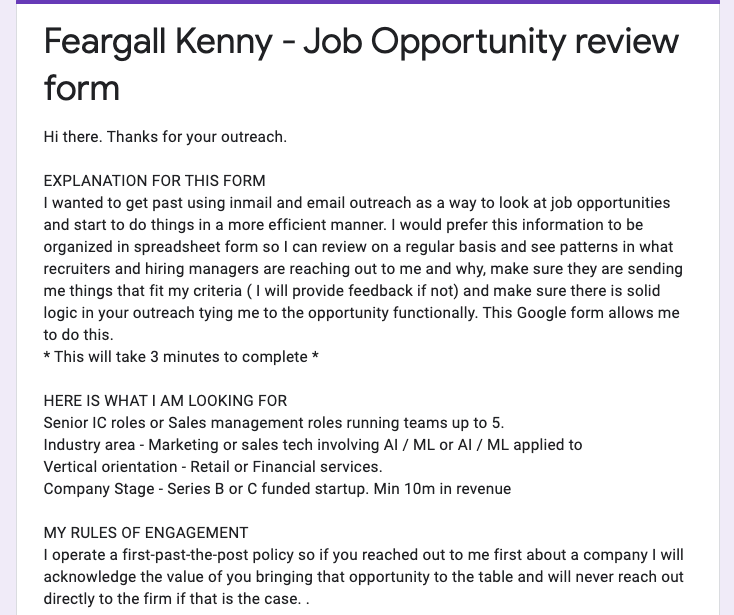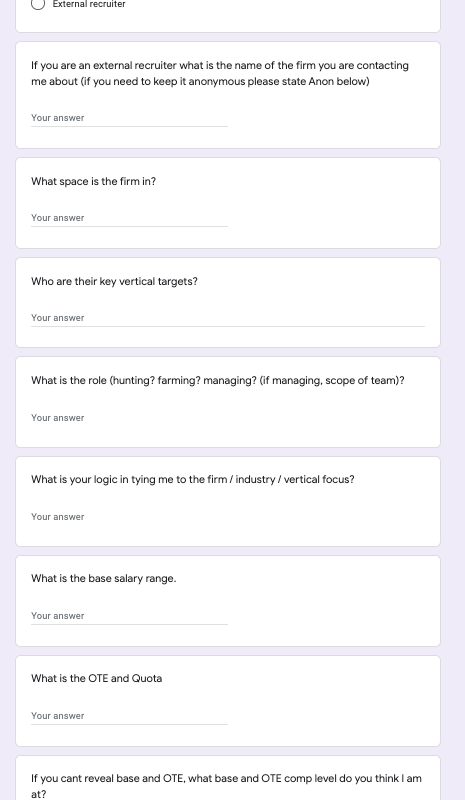17 May

The recruiter-to-candidate outreach part of the recruitment process is highly inefficient for both parties. I think there is a better way that benefits everyone.
Linkedin InMail and email are often the default method of approach and both are rife with inefficiencies. Here’s the challenge from a candidate’s perspective:
- Fluffy language. Recruiting outreach is by definition sales-ey in nature and that language often makes it hard to decipher the industry, the vertical orientation (for sellers), the seniority and the implied comp – ie how relevant the opportunity is to you.
- Companies often anonymized. This is often done for good reason from a recruiter’s perspective. it…….
a) protects them from candidates doing an end-run
and
b) adds a bit of mystery to encourage candidates to respond to them to hear the “reveal” of the clients’ name.
….but that adds to the lack of clarity behind the outreach in the candidate’s eyes
- A level playing field for every outreach. Thoughtful recruiters apply logic to their outreach but they directly compete for attention with spray-and-pray recruiters that don’t.
- Timing. You get too many InMails when you aren’t looking and can’t remember the good ones when you are looking and nothing is in an easy format for you to review them when you are ready to do so.
The upshot is that no one wins – Candidates are still inundated and can’t spot the good opportunities from the bad. Good recruiters also get lost in the shuffle. I would argue that those 4 issues can be summarized into one key problem: InMail outreach is unstructured and because of that there is NO STRUCTURED DATA that is easily accessible in one place to analyze the opportunities and compare their relative strengths.
So, how do you make outreach more structured in a way that you can filter through the good opportunities and the thoughtful recruiters? My low tech suggestion:
A combination of Google forms and Google Sheets!
In the past, I have built tools from scratch to sort out various areas of candidate and recruiter workflow (e.g. declaring yourself open to opportunities with Hiresignals and for job discovery with Job elevation) but, for this problem, I actually think this low-tech combo works well.
The suggested approach
I suggest that you respond to recruiters outreach with a link to a Google form customized to your needs that requests certain information from recruiters INCLUDING the logic behind their outreach to you (Spray-and-Pray recruiters will have trouble with that) and details around comp and seniority.
Use this form as a template . Add an Intro paragraph about yourself and the types of things that you generally look for in the preamble to the form – culture, stage of the firm, other career goals etc.


Then create a spreadsheet (example here) associated with the form that you can refer to whenever you are ready to look. You can check it regularly when you are looking.

You now have structured data, fuller information on the companies and the recruiters they are aligned. You can filter the opportunities and, over time, you should get to see the same thoughtful recruiters multiple times sharing their logic with each opportunity they approach you on. The cream will rise to the top.
Rules of engagement
I would encourage you to respond to the good recruiters and give them guidance when they haven’t exactly hit the nail on the head in their outreach. Then track how they adapt to your guidance from that.
I would also advise you to protect the recruiters that respond. If they divulge their clients then I would ask that go through them if you are interested in pursuing that particular opportunity – especially if they approaching you on it first. Operate a first-past-the-post rule for outreach for specific companies and even clarify that approach in your Intro section suggested above.
Let me know how you get on. At Glenborn we look forward to seeing this applied and proving our worth in our responses to these forms.
